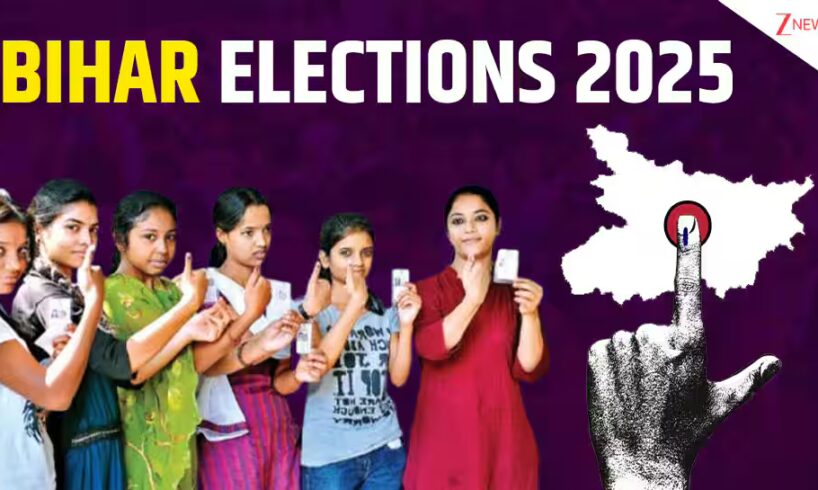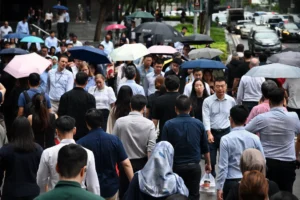
Bihar Elections 2025: The Election Commission of India (ECI) has announced the Bihar polls dates and the 243 assembly seats will go to the polls in two phases – November 6 and November 11. With these high-stakes elections around the corner, political parties and their leaders have ramped up efforts to win over voters. Two key voter segments that remain crucial in Bihar are women and Gen Z—the youth born between 1997 and 2012, aged 13 to 28, over half of whom are eligible to vote. Notably, there are 7.43 crore voters in Bihar, out of which 3.5 crore are female and 1.77 crore are youth, including first-time voters. Together, they amount to over 50 per cent of the state electors, and if tapped correctly, they can play a decisive role in forming a new government.
According to official voter turnout data from the ECI, women in Bihar showed higher participation than men in the 2024 General Elections, with 59.39 per cent of female voters casting their ballots compared to 53.28 per cent of male voters.
First-time voters and young voters under the age of 28 are also expected to play a significant role in the upcoming state assembly elections, as their priorities differ from those of traditional Bihar voters. While caste continues to be a crucial factor in Bihar’s politics, issues such as job creation, infrastructure development, and women’s safety are increasingly shaping voter concerns. Youths are more concerned with exams and employment issues.
Add Zee News as a Preferred Source
Also Read: Bihar Polls: Will Muslims Trust NDA Post Waqf Law? SIR To Dent Nitish Govt’s Image? JDU Responds
Political parties’ manifestos have not yet been published or circulated. However, the ruling party is striving for its economic empowerment, while opposition parties are promising them both economic and social empowerment.
Women Voters In Bihar
National Democratic Alliance (NDA), led by Chief Minister Nitish Kumar of Janta Dal (United) who is a long term and strong player in the Bihar political battleground, is using every weapon in their arsenal to up the game ahead of the polls and transferred Rs. 10,000 each on Monday to 21 lakh beneficiaries under the Mukhyamantri Mahila Rojgar Yojna through Direct Benefit (DBT). This was the third installment under the scheme.
On the other hand, under the Mai Bahin Maan Yojana, Mahagathbandhan, with Congress and Rashtriya Janata Dal (RJD), has promised Rs. 2,500 per month to eligible women if they form the government.
What Role Will Women Voters Play In Upcoming Bihar Elections?
D. M. Diwakar, former Director at the A. N. Sinha Institute of Social Studies, Patna, and currently associated with the Development Research Institute, Jalsain, Bihar, stated that women will continue to make up a larger share of the electorate in Bihar due to male migration.
“There will always be more women voters in Bihar because men migrate for jobs. So, their percentage will always be higher,” he explained.
“When we did our study, we found that if elections are held during festivals, migrant men tend to return home, increasing the percentage of male voters. With Diwali and Chhath falling in between, it’s difficult to say whether they will stay or leave. In such a situation, the major percentage of voters will still be women.”
Key Issues Motivating Women Voters
Speaking on current political strategies, Diwakar said that governments tend to roll out schemes right before elections.
“Whenever elections come, political parties dominate the news and start implementing schemes based on their calculations. Some of these are new, while others are relaunches of earlier initiatives,” he said.
“For instance, there’s a scheme offering ₹10,000 for women’s employment. If money is directly deposited into accounts, it creates a positive perception. People say the government has opened its treasury, though they’re unsure if it will continue after the election,” Diwakar continued.
Gen Z Voters In Bihar
On the second day of his Bihar Adhikar Yatra, Leader of Opposition (LoP) in the Assembly, Tejashwi Yadav, promised the people of the state that “we will give you a Bihar that gives employment, respect, and security.” Meanwhile, CM Nitish Kumar’s government has promised to provide jobs and employment to 50,000 more people. The NDA has promised that in the next five years, one crore youth will be given jobs and employment.
What Are the Key Issues Motivating Bihar’s Women and Youth?
Anil Kumar Roy, a political scientist, highlighted that women and youth are motivated by different sets of issues.
“In Bihar, the issues that motivate youth and women are different. Youths are more concerned with exam-related problems and unemployment. Their dissatisfaction has been visible on the streets,” he said.
“Corruption and administrative mismanagement also deeply upset them,” he added.
How Do Caste and Community Dynamics Intersect with Gender and Age in Shaping Voting Behavior in Bihar?
On caste and identity politics, Roy emphasised that these remain core to Bihar’s electoral landscape.
“The caste issue is a major issue in Bihar. Political parties are formed based on religion and caste, and candidates also mobilize support along these lines,” he said.
“Voting is exciting for young people. They feel they are participating in shaping the government,” Roy added.
He added that the role of youth and women in politics will only grow in the coming decades.
Key Issues That Motivate Youth Voters
On youth concerns, he noted growing disillusionment and brought up the issue of migration in the state.
“Young people feel they’re not getting anything here, especially in terms of employment. Promises like one crore jobs by Modi ji have fallen flat. Last time it was two crore jobs a year; in Bihar, they promised one crore,” he added.
“The youth are disheartened. The ruling party seems unable to connect with them. The opposition is now targeting issues like education, employment, and income, which could mobilize the youth in their favour,” he said.
Social Media’s Role
On the influence of digital outreach, Diwakar explained that social media has limited reach in rural Bihar.
“Social media platforms are effective only for a small segment of the population. Not everyone in Bihar has internet access. Many youths can’t afford data plans or even keep their phones charged,” he said.
“People often say their recharge has expired. It’s worse in rural areas. Social media might have an impact in urban areas or among migrants who now have access to the internet. They engage with memes, reels, WhatsApp groups—but the rural, low-income youth are just struggling to survive,” Diwakar explained.
As Bihar prepares for its 2025 assembly elections, experts agree that women and youth will be decisive forces, though their motivations differ widely. While women are more likely to turn out at the polls, especially with the help of targeted welfare schemes, youth voters are increasingly frustrated with unmet promises around employment and education. For political parties, understanding and addressing these layered realities will be key to gaining ground in one of India’s most politically complex states.





